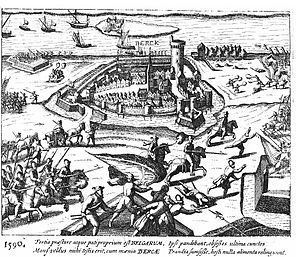Result Spanish victory | Location Rheinberg, Germany | |
 | ||
Similar Battle of Delft, Capture of Aalst, Siege of Niezijl, Siege of Rees, Battle of the Lippe | ||
Siege of rheinberg 1586 90
The Siege of Rheinberg 1586–1590, also known as the Capture of Rheinberg of 1590, took place at the strategic Cologne enclave of Rheinberg (present-day North Rhine-Westphalia, Germany), one of the principals crossing-points over the Rhine on the stretch between the Electorate of Cologne and the Dutch border, between August 13, 1586, and February 3, 1590, during the Eighty Years' War, the Cologne War, and the Anglo-Spanish War (1585–1604). After an initial siege in 1586, and a long blocking by the Spanish forces until September 1589, Don Alexander Farnese, Duke of Parma (Spanish: Alejandro Farnesio), commander-in-chief of the Spanish army, sent a substantial force, under Peter Ernst, Count of Mansfeld, to besiege Rheinberg. Despite the efforts by Maarten Schenck van Nydeggen (until his death at the Assault on Nijmegen on August 10, 1589), and Sir Francis Vere (from 1590), to relieve the fortress city, the Protestant garrison finally surrendered to the Spaniards on February 3, 1590.
On August 19, 1597, the Dutch army led by Maurice of Nassau captured Rheinberg for the States in his successful campaign of 1597, but the following year the Spanish Army of Flanders led by Don Francisco de Mendoza retook the strategic place, forcing the garrison to surrender.
